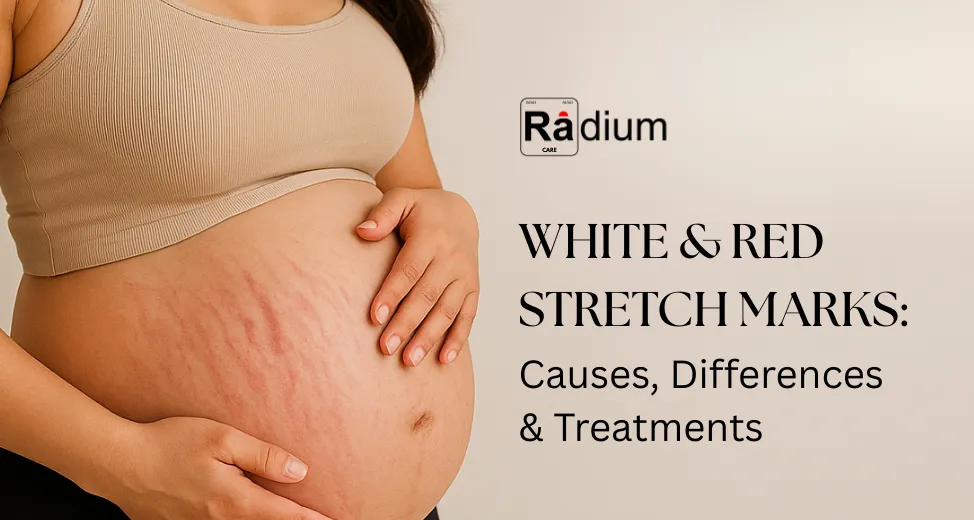Stretch marks — officially striae — are one of the most prevalent transformations our skin experiences, but somehow they tend to hold a more profound emotional resonance than their physical size might indicate. They are bodily records of growth, change, and the resilience of the body, but not everyone looks back on them nostalgically. For some, they are badges of honor of motherhood, of strength, or of personal growth. For some people, they may induce an episode of self-consciousness or irritability, particularly if they suddenly appear.
They develop when the skin is pulled beyond its natural elasticity and causes microtears in the dermis, the second layer of skin. These are then repaired by the body with scar tissue, forming the visible streaks we know as stretch marks. Depending on their age, they can vary in color — new marks tend to be red, pink, or purple because there is more blood flow, whereas old marks become pale or silvery-white as blood vessels close and collagen fibers are rearranged.
Stretch marks may occur anywhere, but they are most frequent in those areas that are subject to sudden expansion, including the stomach, thighs, hips, breasts, upper arms, and buttocks. Pregnancy is perhaps the best-documented reason, but they can also be caused by sudden weight loss or gain, growth spurts during puberty, extreme muscle building, certain drugs such as corticosteroids, and medical conditions affecting hormone levels, including Cushing’s syndrome.
It is worth noting that stretch marks are not a sign of ill health, poor hygiene, or abused skin. They’re merely a visual cue of the body’s ability to adapt — a testament that your skin has endured a time of intense change. Nevertheless, in a world where flawless skin is always touted, it makes sense that most look for ways to avoid, reduce, or eliminate them.
By discovering the distinctions between red (new) and white (older) stretch marks, and investigating the existing treatment techniques, you can make educated choices regarding dealing with them — whether your desire is to minimize their appearance or merely accept them as part of your body’s individual history.
How Stretch Marks Form
Your skin contains three basic layers:
- Epidermis – the outer covering layer
- Dermis – the middle layer, which is high in collagen and elastin
- Hypodermis – the innermost fat layer
Stretch marks happen when the skin is stretched beyond its own natural elasticity, propelling its structural collagen and elastin fibers past their breaking point. Instant tension causes microscopic dermal tears — in the middle, strongest layer of the skin. When the body tries to repair these tears, it creates scar tissue, resulting in the rough streaks that we recognize.
In the early stages, the tiny blood vessels beneath the skin become more visible through the damaged tissue, giving the marks a reddish, pink, or purplish hue. This is also the reason that more recent stretch marks look more prominent. With time, these blood vessels tighten and circulation slows down, and the marks fade away. All that remain are pale, silvery-white lines — older stretch marks which are less red but also conceivably more resistant to treatment.
Why Do They Appear?
There are certain causes which help in the development of stretch marks:
- Pregnancy: Because the belly gets bigger to accommodate the baby, the skin stretches significantly, usually imparting stripes on the belly, breasts, hips, and thighs.
- Sudden Weight Change: Either through gain or loss, sudden changes in body mass can overwhelm skin elasticity.
- Growth Spurts: Teenagers undergoing puberty may increase their height and body weight overnight, leading to bruising on the arm, thighs, or back.
- Bodybuilding: The rapid gain of muscle tissue produces too much skin tension.
- Hormonal Alterations: Diseases like Cushing’s syndrome, or increased corticosteroid levels, may weaken the strength of skin structure.

Red Stretch Marks: Early Stage (Striae Rubrae)
Red stretch marks are recent, fresh scars. The reddish or purplish color because the dermis has only broken and the underlying blood vessels become visible.
Chief characteristics:
- Color: Purplish, pink, or red
- Texture: Slightly raised
- Sensation: May be itching or painful
Why they are important:
At this stage, the markings are most responsive to treatment. Collagen production is still possible to stimulate to rebuild skin structure more intensely.
Treatment methods for red stretch marks
- Topical creams & oils: Topical creams that include retinoids (avoid during pregnancy), hyaluronic acid, and peptides have been found to induce collagen.
- Moisturization: Daily hydration of the skin with shea butter, cocoa butter, or almond oil can enhance elasticity.
- Laser therapy: Procedures such as pulsed dye laser (PDL) can decrease redness and stimulate regrowth of the skin. (Laser treatments should be avoided by pregnant women — always consult a gynaecologist.)
- Microneedling: Induces micro-injuries to trigger the repair of collagen and elastin.
White Stretch Marks: Mature Stage (Striae Albae)
Red marks fade out into silvery-white streaks. This is when blood vessels constrict and the scar tissue is what’s left.
Key features:
- Color: White or silvery
- Texture: Wrinkled or sunken
- Age: Months to years old
Why they are more difficult to treat:
White stretch marks are those which are more aged and indicate the last phase of healing of the skin after it has been overstretched past the natural limit. At this point, elastin and collagen fibers below have already been destroyed and replaced with scar tissue by the body. Vessels that were previously causing red or purple marks with their color have receded, making the marks pale or silvery. White stretch marks treatments tend to be targeting the cosmetic improvement of texture in the skin, the stimulation of collagen production, and the camouflage of pigmentation by the adjacent skin. The techniques cannot restore the original skin structure despite reducing their appearance.
White stretch mark treatments:
- Fractional lasers (Fraxel, CO₂): Treat deeper layers to stimulate the growth of new collagen.
- Excimer laser: Helps restore pigment, making marks less noticeable.
- Microneedling with PRP (Platelet-Rich Plasma): Uses your own growth factors to encourage skin repair.
Pregnancy-Safe Approaches
For pregnant women, safety comes first. While certain treatments must be avoided, there are still gentle practices for skincare:
- Apply fragrance-free, hypoallergenic moisturizers every day.
- Wear supportive clothing to minimize pressure on the skin.
- Gain healthy weight steadily as advised by a doctor.
Lifestyle Tips for Prevention & Care
While genetics will play a huge part in whether you get stretch marks or not, healthy lifestyle can minimize severity:
- Water: Maintain enough water to sufficiently maintain skin hydration.
- Balanced diet: The food available to you should be nutrient dense, always try to eat foods rich in vitamin C, vitamin E, zinc, and protein to maintain collagen.
- Limit dramatic weight changes: Try to avoid sudden weight gain or loss as much as you can.
- Sun protection: Sun immediately has the ability to enhance a scar.

Myths Debunked Regarding Stretch Marks
- Myth: Only women get stretch marks.
Fact: They can also appear in men, particularly with rapid muscle growth or during spurt growth.
- Myth: Stretch Marks Indicate Unhealthy Skin.
Fact : Stretch marks are caused by the skin being stretched, and stretch marks can appear on healthy people too. Stretch marks will occur no matter what the healthiness of the skin when it is stretched.
- Myth: You can get rid of your stretch marks completely.
Fact: Treatment can lead to filling material and out-of-balance texture, but removal is an exception.
When to See a Dermatologist
Seek a professional if:
- Stretch marks develop suddenly without specific cause.
- They are associated with other signs such as weakness, weight changes, or loss of skin thickness.
- You would like more treatments that are advanced like microneedling or laser.
The Emotional Side
While stretch marks may be benign from a clinical perspective and cause no physical harm to your health, they can affect your self-esteem and body confidence in a culture that sub-consciously glorifies stunning, pristine, flawless skin. Remember that the natural marks are so much more than lines across your skin — they are tangible proof of your body’s innate ability to grow, change, and repair itself. They could be the result of a miraculous journey of creation, the lamentations of the pursuit of fitness, or the gradual and yet inevitable metamorphosis we all endure through age, hormonal changes, or lifestyle choices. Each imperfection is a silent homage to experiences of strength and change, and viewed with empathy, they are more than just a mark they are representations of your own unique adventure.
Final Word
Whether red or white stretch marks may have different ages, colors, textures, and responses to treatment, they all reflect the skin’s physiological response to stretching beyond its limits. The red or purplish stretch marks are newer and therefore inflammatory. The tiny blood vessels under the skin are still functioning and are visible as the most fresh appearance in the inflammatory stage. appearance. Newer stretch marks are more amenable to topical treatments and moisturizers, and targeted dermatological procedures aimed at promoting collagen production and improving skin elasticity will also have the best effect on new stretch marks. Over time and as part of the healing process, stretch marks lose their color, diminish in blood supply to the skin through the dermis, hypertrophy, and become white or “silvery” scars. White or silvery stretch marks are, in general, more resistant to basic home treatments, however, if willing to seek modern interventions such as laser therapy, microneedling and platelet-rich plasma (PRP) treatments, then those new technologies should fairly quickly substantially improve the smoothness and tone of previous stretch marks.
At Radium Care, we believe that skin health goes far deeper than what meets the eye — it’s closely tied to your self-image, comfort, and emotional well-being. Stretch marks are not imperfections, but rather normal milestones of development, fortitude and transitions, whether from pregnancy, puberty, weight loss, fitness changes, and other pivotal lives phases. Some people choose to depersonalized or diminished the appearance of their Stretch marks, while some decide to called it their own and wore it with pride – and both. choices are equally valid. Ultimately, what is most important is that you are comfortable and at ease in your own skin. Our job is to support you with safe, science-based treatment options, mild skincare coaching, and most of all that your body has a story to be celebrated; every mark is a part of it. It is a unique story, and whether you want to treat them or simply learn more, Radium Care will walk with you every step of the way, providing care and kindness.
FAQ’s
Que: How do you remove red stretch marks quickly?
Ans: Red stretch marks are best treated early with retinoids, hyaluronic acid, oils, and procedures such as laser or microneedling, which enhance collagen and reduce the appearance of scars.
Que: Will white stretch marks completely fade away?
Ans: No, white stretch marks are scars and cannot be erased, but they can be reduced by procedures like laser, microneedling, and PRP.
Que: What are the best treatments for stretch marks?
Ans: Topicals such as retinoids target new marks, while microneedling, laser, and PRP target older marks more effectively, making them less noticeable but not removing them completely.
Que: Do stretch marks naturally disappear over time?
Ans: Yes, stretch marks do heal and fade from red to white as the years go by, but they rarely ever leave you.
